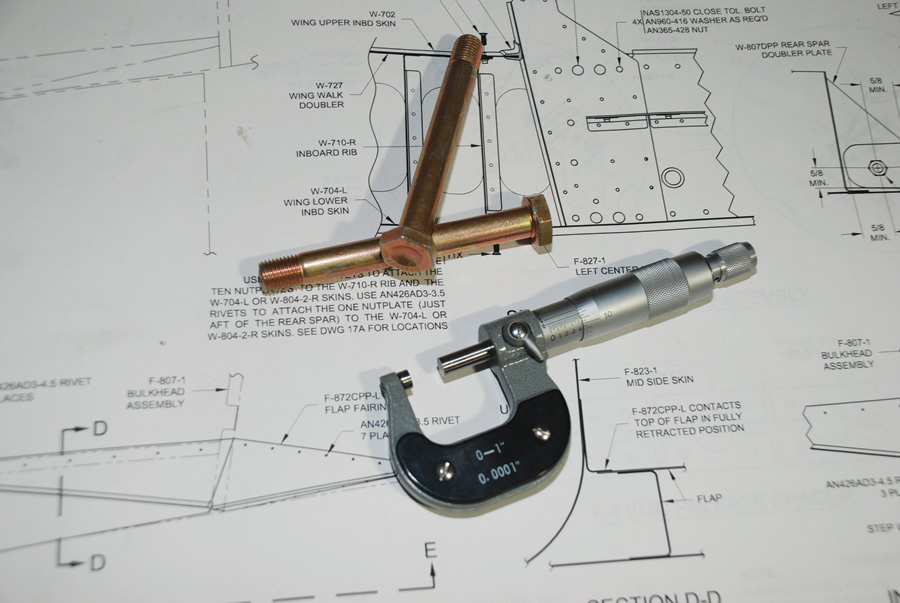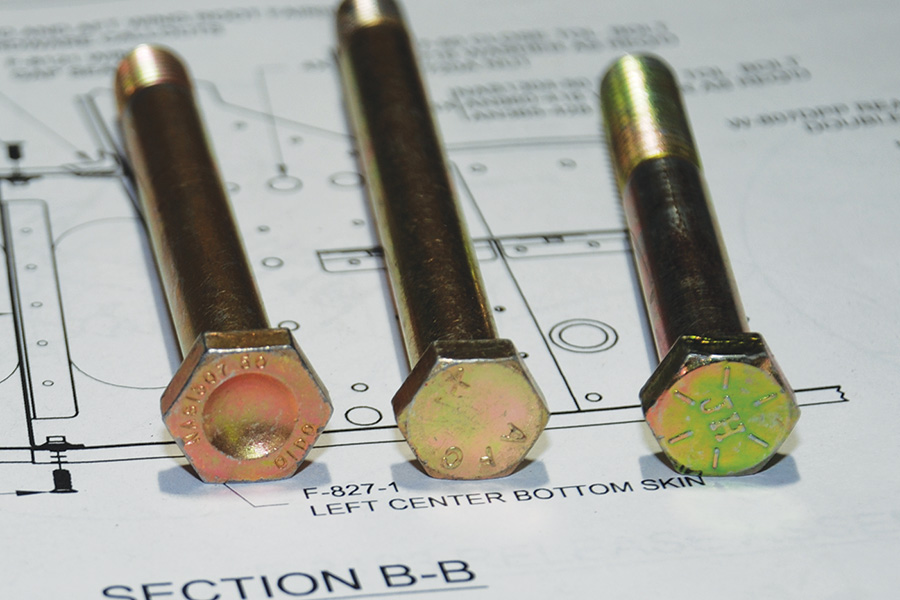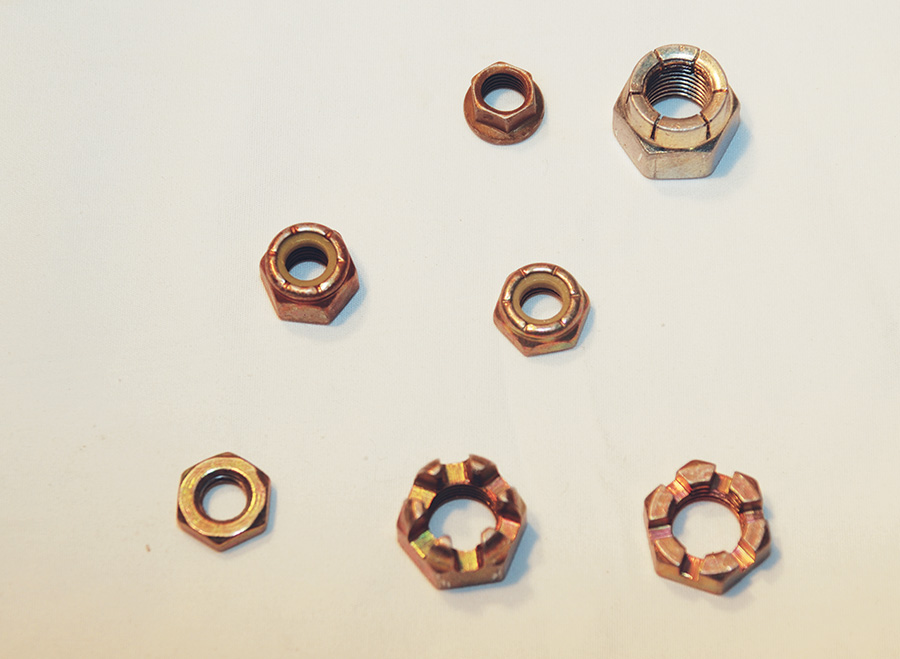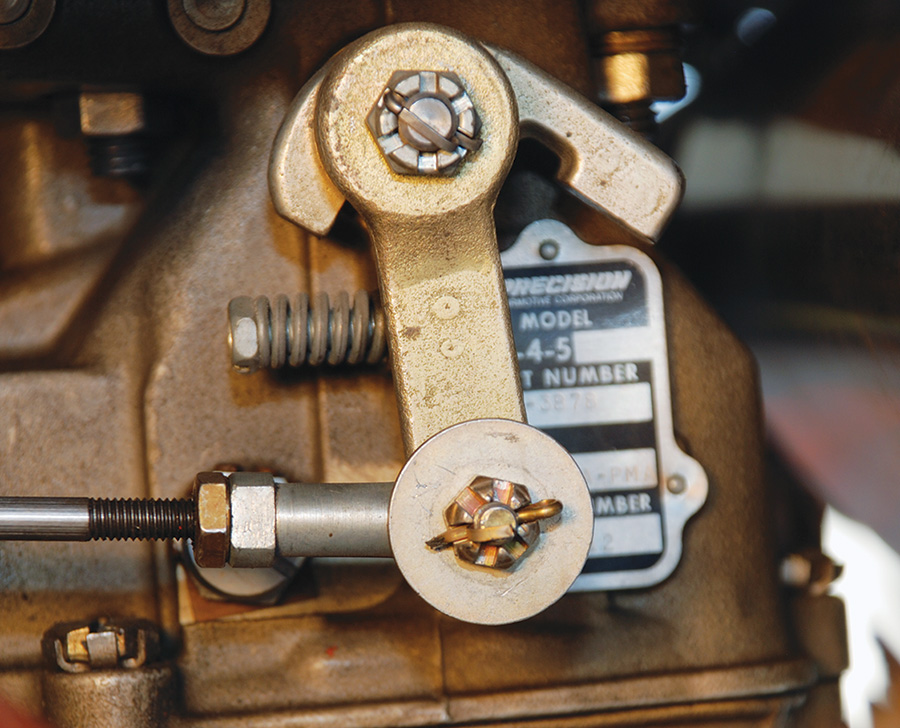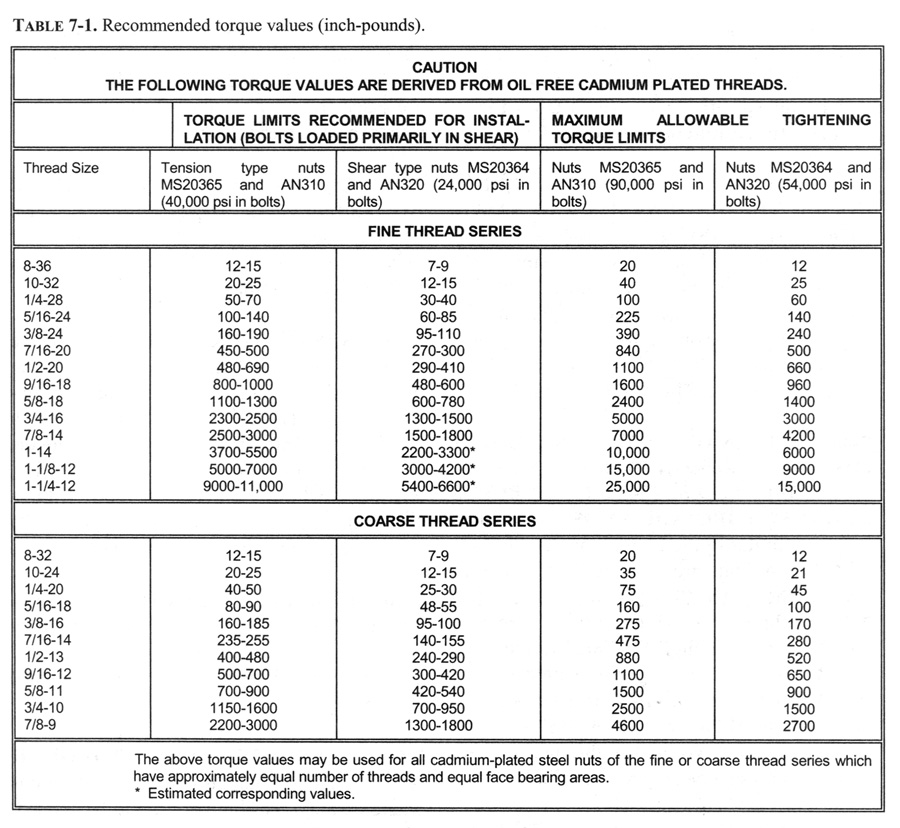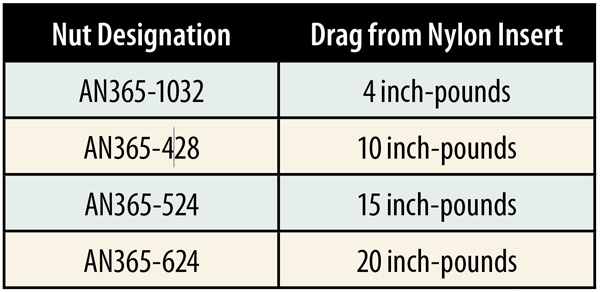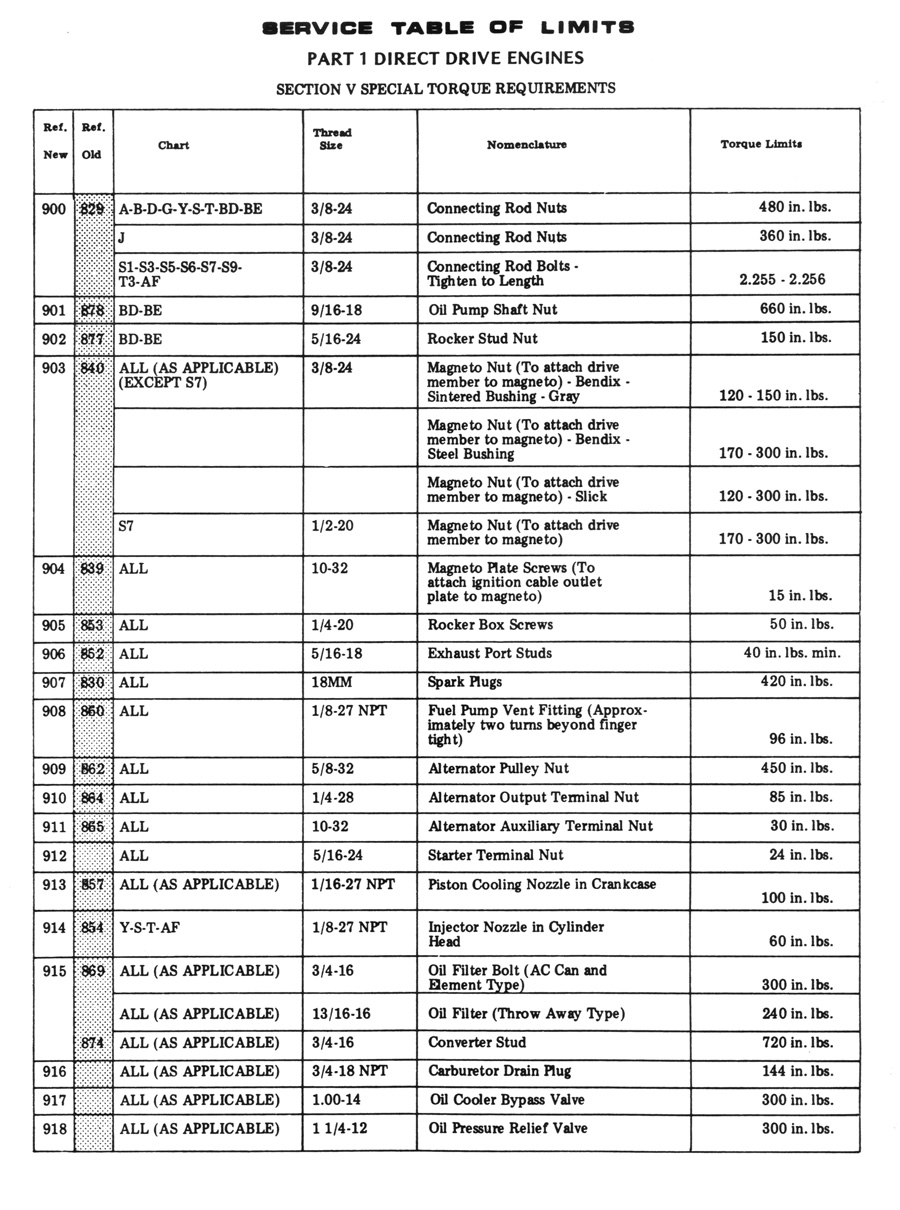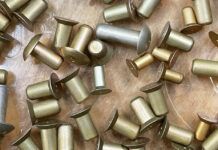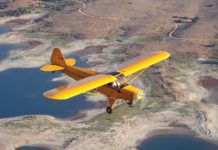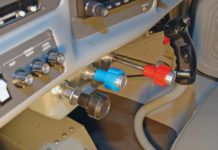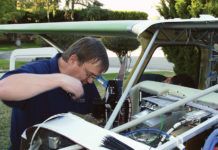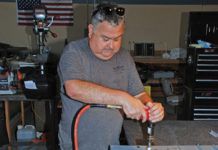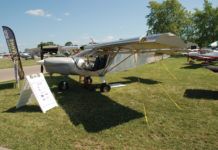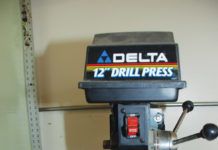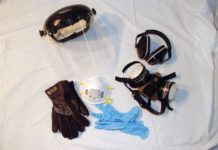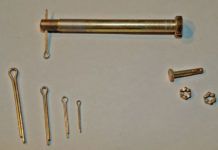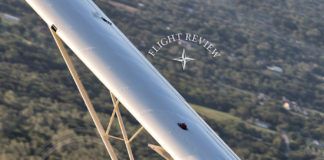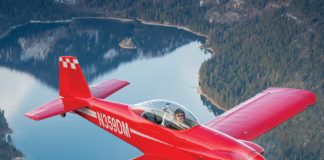Since this series is about best practices, I will unapologetically state that you should only use aviation hardware when building your plane, especially for parts that hold it together and parts that keep it running. I don’t just say this because that’s the way the certificated guys do it. There are no regulations that make you use aviation hardware in your Experimental airplane, but there are a number of good reasons why you should.
AN1307-50 bolts secure the wings to the structure of an RV-8. These bolts have a tensile strength of 160,000 psi and a shank diameter of .4365 +/- .0005 inch. A hole reamed to .4365 inch will allow a tight drive fit even if the bolt is at the maximum allowable shank diameter. The NAS 1300 series bolts are now being replaced with NAS 6200 and NAS 6600 series bolts.
First, most aircraft designs are based on using aviation hardware. By using AN (Air Force-Navy), MS (Military Standard), and NAS (National Aerospace Standards) nuts and bolts, you can be sure that you are providing the strength and fatigue resistance that the designer expected from a builder. Just as you wouldn’t use 6061-T6 aluminum for a part that was designed to be made of 2024-T3 (you wouldn’t, would you?), you shouldn’t substitute commercial hardware from your favorite home center for the specified aviation hardware.
Second, aviation nuts and bolts have much better fatigue strength compared to commercial hardware, even Grade 8, mainly because their threads are formed differently. Little things that you can’t see make a big difference here. Aviation bolts have threads with a larger radius at the bottom of the threads. In addition, they typically have a much longer unthreaded portion of the shank, which gives them a much better bearing surface to deal with shear loads. The thread differences in particular make a big difference in the ability of the bolts to handle fatigue.
Third, while on the subject of threads, the threads on aviation hardware are made to a Class 3 fit, rather than the Class 2 fit of commercial hardware. This better fit does a better job of transferring loads from nut to bolt and thus a better job of holding important airplane parts together. This superior load holding power is not reflected in tensile or shear strength charts, but it is no less important. Along that same line, the dimensional tolerances of aviation bolts are tighter, meaning that you are less likely to get a too-tight or a sloppy fit as you bolt things together.
Fourth, the cadmium plating on aviation hardware gives these items better corrosion protection than the zinc plating typically found on commercial hardware. Better corrosion resistance means longer life in many cases, and a safer bolted connection.
Lastly, aviation hardware benefits from better inspection and record keeping. This ensures that quality standards have been met for every batch of nuts or bolts that an aviation vendor orders. All of this does cost extra, but the peace of mind that comes from consistent, verifiable quality ought to be worth something. You can spend less and probably get by much of the time, but it is similar to the case of buying an inexpensive motorcycle helmet. As long as you don’t crash it doesn’t matter if you are wearing a cheap helmet, but every now and then it really matters.
Bolts
The standard bolts used by most builders for most airframe applications are AN bolts. They are designated by shank diameter, length, and safety wire/cotter pin accommodations. A typical bolt would be an AN3-14A. This bolt has a 3/16-inch shank diameter, which is where the 3 comes from, and an overall length, not counting the head, of 117/32 inches. The A means that there is no hole in the shank or the head for any safety wire or cotter pin. Change that to an AN3-14 and you get a bolt with a hole in the shank for a cotter pin. An AN3H-14 will have holes in both the shank and the head, but an AN3H-14A will only have a drilled head. Luckily you don’t have to memorize this because there are many references readily available, among them the Aircraft Spruce catalog, which is a handy thing to have, even if you buy many of your parts elsewhere. One of these bolts will meet most of your needs most of the time.
From left to right are a NAS1307 bolt, an AN7 bolt, and a 7/16-in. Grade 8 bolt. Note the much longer threaded portion on the commercial Grade 8 bolt. These bolts should not be regarded as interchangeable.
There are also many specialty bolts including high strength bolts, close tolerance bolts, bolts with both of those features, eye bolts, and others. In addition, there are a host of very special bolts used to assemble engines that for the most part are not interchangeable with standard AN hardware. For example, most Lycoming engine bolts have coarse threads, whereas most AN bolts used in airframes have fine threads. There are also some special bolts used inside the engine, such as connecting rod bolts, that are not standard AN hardware. This is why it is very important to follow the engine maker’s overhaul manual and service literature when working on any engine.
Standard AN bolts come in three configurations: AN3-4A undrilled, AN3-4 drilled shank, and AN3H-4A drilled head. Bolts with both a drilled head and a drilled shank (AN3H-4) are also available. The 3 in these bolt designations refers to the shank diameter of 3/16-in. and the 4 refers to the nominal length of 17/32-in.
A type of special bolt most builders will encounter is the NAS bolt. These bolts, with designations such as NAS1307-50, are high-strength, close-tolerance bolts used for attaching the wings to the structure of planes such as the Van’s RV series. These bolts are being replaced with NAS6200 and NAS6600 series bolts, which have similar properties. In the case of the NAS1307-50 bolt, the 7 indicates a shank diameter of 7/16 inch and the 50 means it has a length of 323/32 inch. These bolts have a tighter dimensional tolerance and a higher strength than standard AN7 bolts. In the case of the RV wing bolts, they are what is termed a tight drive fit, meaning there can be a maximum interference fit of .0006 inch. These bolts come with a diameter of .4365 inch +/-.0005. If the holes are reamed to .001 inch undersized (.4355 in), there will be at most a .0005 inch clearance. On the other hand, there will be a maximum interference of .0005 inch depending on the bolt. There is no way to expect a commercial Grade 8 bolt to meet this tight tolerance.
Fatigue strength is not considered in the bolt comparison chart, but it is a very important characteristic of aviation bolts compared to commercial bolts. Note how a commercial Grade 8 bolt can have a shank diameter that varies by .007 inch from one extreme to another.
Bolts that are bent or gouged or have their plating worn off should be replaced, as should bolts with damaged threads. Threads should only be repaired in an emergency because standard machinist’s taps and dies will remove the cadmium plating and will cut sharper points into the roots of the threads, thus reducing the bolt’s fatigue strength. If possible, thread repairs that must be made should be made with thread-chasing taps and dies that remove much less material.
Nuts
The standard aircraft nut is the AN365 nylon insert stop nut. The AN364 is a thin version of this nut for shear applications only, in other words, when the load is perpendicular to the length of the bolt. All-metal stop nuts such as the AN363 and the MS21042 (same strength but different shape) are for use where temperatures exceed 250F, such as in the engine compartment. In fact, best practices dictate nylon insert stop nuts never be used on or forward of the firewall.
Many different types of aircraft nuts are available. Top row, left to right: MS21042 metal stop nut, AN363 metal stop nut. Middle row: AN365 standard nylon stop nut, AN364 shear nylon stop nut. Bottom row: AN316 thin check nut, AN310 standard castle nut, and AN320 shear castle nut.
Castellated nuts (or castle nuts for short) are used whenever there is rotation at the connection or for applications where there is extreme vibration or frequent load reversals. They come in a standard version—AN310 and a shear only version—AN320. They are to be used with a cotter pin, or in some applications with safety wire. Castle nuts and cotter pins should be used for attaching flight controls and engine controls, both applications where rotation is present. Another place where castle nuts are often found is with engine mount bolts where vibration can be severe. Some builders use AN363 nuts on their engine mount bolts, but an AN310 bolt and cotter pin is generally a better choice.
Castle nuts should be used whenever there is rotation involved in the bolted connection such as it is with this throttle linkage.
There are many other types of aviation nuts for special applications. In all cases they are preferred to similar-looking, but not really equal, commercial nuts that you can get at your local hardware store or home center. The differences are similar to those of bolts: cadmium plating, Class 3 threads and tighter dimensional tolerances, greater strength in many cases, and better inspection and record keeping to ensure that you consistently get the quality you pay for.
The question arises, when should I replace stop nuts? The answer is whenever threads become damaged or when the stop feature suffers a reduction in drag. The problem is that every time a stop nut is used the drag is reduced a little bit. A rule of thumb is to replace a stop nut whenever it can be turned by hand. The problem with that is that many people can turn a brand new AN365-1032 nut by hand. At the other extreme a large nut such as an AN365-820 will be way too worn out by the time you can turn it by hand. Maybe a good rule, and there is no published standard for this, is to discard any stop nut that has lost more than one-third of its original drag, and to replace stop nuts at critical connections every time they are loosened. If our readers have seen a better standard, especially something published, please let me know.
Connections subject to heavy vibration and/or frequent load reversals should also use castle nuts. This motor mount nut is a good example of that.
Installation
There is a convention that bolts should be installed so that their shanks point inward towards the center of the aircraft, backward towards the tail, or downward such that gravity will tend to hold the bolt in place if the nut falls off for some reason. This basic rule makes inspection easier and seems logical in the case of a downward orientation, but if clearances or other important considerations dictate some other orientation, no sleep should be lost over violating the rule.
Aside from orientation, a major concern when installing nuts and bolts is to be sure enough of the bolt thread protrudes through the nut to fully engage the stop feature, and to be sure that the nut does not bottom out on the unthreaded portion of the bolt shank before it is fully tightened. The standard practice is to have at least one thread exposed above the top of the nut and not more than three. Thread exposure can be controlled by varying bolt length and the number of washers used. A thick washer is worth about two threads on an AN3 or AN4 bolt.
In an ideal arrangement, we would see a washer under the head and the nut of a bolted assembly, with the washer matching the underlying material—aluminum washers for an aluminum part. Good practice also dictates that no more than three washers should be used with a nut and bolt. The real important thing is that any time there is a shear load, the unthreaded shank must extend fully through the shear load zone so that no load is taken by the threaded portion of the shank. This means that there will virtually always be a washer under the nut in this type of application. Our other concern is that the nut never bottoms out on the unthreaded portion of the shank such that the nut and bolt connection will not be tight.
This torque table is taken from AC43.13-1B. Note the different values for shear and tensile applications, as well as fine and coarse threads. Since most AN bolts have fine threads, it is likely that those values will be the most commonly used.
Torque
The standard way of determining the tightness of aviation nuts and bolts is torque. We can debate the wisdom of using this means compared to others such as bolt stretch, but torque is how things get specified in the aviation world, so torque is what we will use unless specified otherwise. Many publications including AC43.13-1B have torque tables for aircraft bolts and nuts, typically with tables for tension loads using standard nuts and shear loads using thin nuts. These tables usually also include values for coarse thread nuts and bolts, but AN hardware almost always has fine threads.
Torque table values are based on clean, dry threads and do not take into account the drag of stop nuts. To be accurate, the stop nut drag needs to be added to the torque table value to get to the proper tightness. Since there is no published standard for stop nut drag in these aviation references you may need to measure the drag yourself. This is most easily done with a beam-type torque wrench, but a clicking wrench can be used if you approach the drag torque in increments. These values in the table come from my own measurements.
When using castle nuts, the nut should be installed with the minimum torque value listed in the table and then turned to line up the next slot for the cotter pin. This would be the practice unless the specific task called for some other method as per the kit designer or component manufacturer. Often adding or subtracting a washer can help line up the hole and the slot in the castle nut.
Please note that many engine bolts will have torques specified for them that are not the standard torque table values. Furthermore, many of the bolts will have specified torques based on lubricated threads. It is vitally important that the engine or propeller manufacturers’ most up-to-date overhaul manual and service literature be consulted for the correct values and use of lubrication. Just as you should not install a standard AN bolt inside an engine unless it has been specifically specified, you should not simply use a standard torque table to determine the tightness of any engine nut or bolt. Best practices mean that you take the time to get the correct nut or bolt for the task at hand and further take the time to determine exactly how it should be installed. The information is available, but you do have to look for it.
This is a torque table from Lycoming’s Direct Drive Engine Overhaul Manual, dated December 1974. Note that the recommended torque values are seldom exactly the same as those on the standard torque table in AC43.13-1B. Be sure you use the most current version of the manufacturer’s overhaul manual when actually performing engine work, and consult their service publications for any revision that may have taken place since the manual’s publication.
A lot of research and experience backs up the design of aviation hardware. Even though it is usually more expensive than commercial hardware, there are good reasons for the differences. Substituting commercial hardware for aviation hardware is not a good place to save money on your project. The added value of best practices in this regard is realized in greater safety and lives saved. Use the good stuff. You’re worth it.


